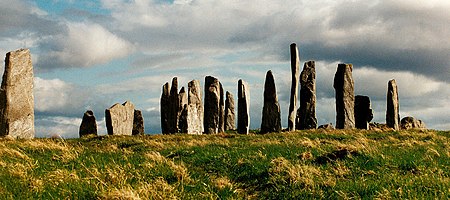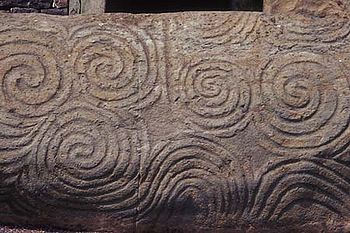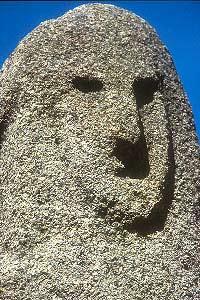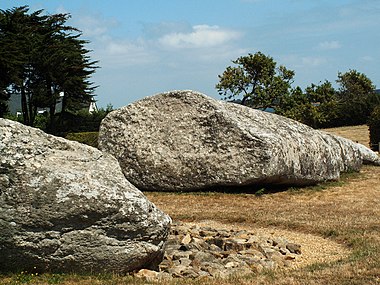Megalithism: megaliths in the world, megalithic Europe, Origins in Europe, An art in itself
Megalithism

The site of Callanish on the Isle of Lewis in Scotland, photographed in 2000
The megalithism is a form of architecture practiced around the world at different times and in particular in Europe by the peoples of the prehistoric recently, the Neolithic (about 5000 to 2000 BC) or much more rarely in the protohistoric.
The term "megalithic art" is also used to refer to the use of megaliths (from Greek mega = large; lithos = stone), literally large stones erected by prehistoric groups for religious or burial but also as artistic medium. It does not apply to the use by some modern artists and sculptors "big rocks" in their work: the term is generally used to describe art carved on megaliths in prehistoric Europe.
The term "megalithic" refers to both the art of building monuments, megaliths (dolmens, menhirs, stone circles, cairns, henge, peulvens, Tholos, covered walkways, Taulas of Balearic, brochs of Scotland), the period in which these buildings were erected and their scientific study by archaeologists and pre-historians, who try to understand its meaning.
The megaliths in the world
The temporal succession of different currents megalithic does not imply in any way a relationship of descent between them. The megalithism is a widespread phenomenon in the world, with specific regional
- alignments Atlantic or northern Africa;
- circles English, Scottish or Orkney;
- "Graves of giants" and nuraghi Sardinian;
- torres Corsican;
- Taulas Balearic;
- cromlechs Welsh;
- menhirs, dolmens in mounds or under cairn;
- chen-pin Korean;
- Kofun Japanese;
- altars Olmec;
- anthropomorphic Colombia;
- moai Easter Island, etc..
The megalithic Europe
Built mostly between the fifth and fourth millennium BC. AD, dolmens and standing stones are the finest monuments of European megalithic. They are the work of farmers and herders who lived in this area during this phase of the Neolithic. They are among the earliest monuments of the continent. If they seem to defy eternity, he must know that the condition in which they have come down to us is often far from their original appearance. Large slabs Assemblies of dolmens represent skeletons often very elaborate tombs, theater complex funerary practices. A large number of standing stones, menhirs and stelae now isolated, are only the remnants of much larger devices the service still uncertain.
Origins in Europe
On the site Skorba to 5 200 BCE during the phase Għar Dalam, the Maltese megalithic above approximately 700 years the cairn Barnenez and about 1200 years the alignments of Carnac The Maltese megalithic takes all its breadth and originality in the archipelago during the later stages. For the Maltese archeology, this is not the master of stone or metal that punctuates the prehistory but the evolution of megalithic temples. The coming period is called the period temples (4 100-2 500 BCE), it takes 1 600 years and is divided into five phases.
The mastabas (2 700 BCE) and the pyramids of Egypt (2 500 BCE) were contemporaries of the last temples of Malta as a double horseshoe of bluestone (2 600 BCE), the triliths (2 400 BCE) and the circle sarsen of Stonehenge (reworked until 1 600 BCE). The large Maltese megalithic period is completed for about 700 years during the construction of the old temple of Knossos (1 900-1 800 BCE).
An art in itself

Engraved stone at the entrance site of Newgrange, one of the most famous archaeological sites of Ireland, County Meath, north of Dublin
Although the primary function of the architecture was not directly megalithic art but of religion, the megalith is often the preferred art of his time. For example, orthostats of dolmens can be decorated with engravings whose complex symbolism escapes us, they may also have been carved and submit an anthropomorphic shape, and akin to genuine prehistoric statues, some of which are gendered (featuring breasts ) and have rows of necklaces. Similarly, the statue-menhirs are megaliths whose engravings sometimes very advanced and many witnesses of the artistic activity of prehistoric men, art joining the sacred.
An uncertain science

Head carved on top of a menhir, Filitosa, Corsica
The habitat and lifestyle of the builders of megaliths raises many questions, which scientists try to answer. The understanding of these extinct cultures requires the study of objects (pottery, stone tools and bone) and monuments that have survived after being sometimes reused by other civilizations, looted, destroyed over the centuries . The megalithic archeology branch of prehistoric remains an uncertain science, "a science of vague" in the words of prehistorian Serge Cassen, based on assumptions. The graves, their architecture and furnishings are an essential part of this research. We do not know much about construction methods of these imposing buildings, erected by huge blocks of stone. These buildings, witnesses of the first monumental architecture in the history of mankind, were built, mostly used for burials, by organized societies.
Initially, research on megalithic will concentrate on defining the environment in which fits the megalithic architecture. Intervene then another problem, that of dating, to allow the establishment of a chronology. And again, there are many uncertainties.
.png/350px-Estela_de_Logrosan_(Caceres-España).png)
Funerary Stela of Castro Solana Cabañas at Logrosán (province of Caceres in Spain)
Since 1944, Pierre-Roland Giot creates, within the Faculty of Science of Rennes, Laboratory of Prehistoric Anthropology, in which he applies scientific techniques to the archeology: petrography of polished axes, spectrography of metals, sedimentological study of deposits Paleolithic among others. It will run for forty years the major excavation and restoration of monuments and megalithic burial mound and form a team of seasoned prehistory. Among his students there are the names of Yves Coppens, Jacques Briard and Jean L'Helgouach, joined later by Charles-Tanguy Le Roux, Pierre-Louis Gouletquer, Marie-Yvane Daire and Henry MORZADEC.
The megalithism today
The megalithic civilization has not completely disappeared. If the Bantu of Ogoja province, south-eastern Nigeria, only raise more phallic Akwanshi last hundred years as the Kelabit of Sarawak, by the cons Malagasy plateau of Imerina, the Konso of Ethiopia and the Toraja of Sulawesi or the people of Sumba in Indonesia still stand today megaliths to honor their dead and enhance the status of the family or clan. This requires, as it was millennia ago, enormous physical and economic costs but also a spirit of cooperation that strengthens the unity of ethnic groups that still practice the megalithic
The mysteries of megalithic

Lying on the ground, two of the four pieces
the great broken menhir of Er Grah at Locmariaquer (Morbihan)
The megalithic civilizations have developed mostly in the Neolithic. The erection of these monuments (dolmens, menhirs, stone circles, etc ...) still raises questions.
The first is technical. It examines the techniques used for the transport of such stones, so large, several kilometers, and their implementation by men with only rudimentary equipment. Presumably, with time, using levers and a workforce in large numbers, it was possible to move the stones of 20 or 30 tons of drag on the rollers, and make the switch on inclined planes to train them. But when the stones weigh over 100 tons (as the great broken menhir of Er Grah at Locmariaquer (Morbihan), the largest menhir in the world, nearly 20 m and about 350 tons), it seems difficult . Similarly, some slabs covering dolmens - as always in Locmariaquer, that of Mane Rutual, for example, where the slab 11 meters long (40 tons) seems disproportionate to the room - does not seem to have been raised by levers of wood, which would be broken.
Furthermore, we found that certain alignments or stone circles seem to correspond in all respects to the path of a underground river [ref. Needed], so invisible, and it is unable to explain why.
There remains the question of the meaning of the erection of these monuments. The megalithic has a distinctly religious aspect. We know nothing of this religion, its rituals, its ceremonies. It was, in some cases linked to the death. Some monuments, dolmens, Barrow, cairns ... appear to be graves. However, close alignment, such as those well known to Carnac, of stone circles, or some menhirs, no bone was found. They were therefore likely another function. Among the theories more or less serious circulating to try to explain this mystery, we include three that do not shred of scientific verification:
Some believe that the megaliths were landmarks for travelers.
Other nodes that correspond to the terrestrial land.
Some argue that these are astronomical landmarks or markers of a geometry ancestral.
According to archaeologists such as Jacques Blot, if at times the stones can be related to the worship of the sun and stars, it is likely that isolated menhirs are an ancient boundary mark the transhumance routes. Jacques Blot remark that Pays Basque, the standing stones are located on major thoroughfares: passages of shepherds, inland salt ... Other times, the menhir can also commemorate an event or an important person.
Like it on Facebook, Tweet it or share this article on other bookmarking websites.

